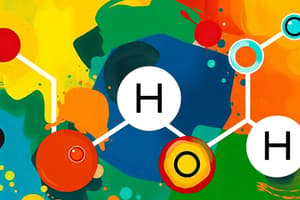Podcast
Questions and Answers
Which of the following functional groups is characteristic of alcohols?
Which of the following functional groups is characteristic of alcohols?
- -OH (correct)
- -COOH
- C=C
- -NH2
Stereoisomers have different connectivity but the same spatial arrangement.
Stereoisomers have different connectivity but the same spatial arrangement.
False (B)
What is the main difference between Lewis acids and Lewis bases?
What is the main difference between Lewis acids and Lewis bases?
Lewis acids are electron pair acceptors, while Lewis bases are electron pair donors.
In thermodynamics, the change in heat content of a system is represented by ______.
In thermodynamics, the change in heat content of a system is represented by ______.
Match the following types of reactions with their descriptions:
Match the following types of reactions with their descriptions:
Which of the following is NOT a type of inorganic compound?
Which of the following is NOT a type of inorganic compound?
Oxidation states are important for understanding the reactivity of elements in coordination compounds.
Oxidation states are important for understanding the reactivity of elements in coordination compounds.
What is represented by the Schrödinger Equation in quantum chemistry?
What is represented by the Schrödinger Equation in quantum chemistry?
Flashcards are hidden until you start studying
Study Notes
Organic Chemistry
- Definition: Study of carbon-containing compounds and their properties.
- Functional Groups:
- Alcohols (-OH)
- Carboxylic Acids (-COOH)
- Amines (-NH2)
- Alkenes (C=C double bond)
- Isomerism:
- Structural Isomers: differ in connectivity.
- Stereoisomers: same connectivity but different spatial arrangement (e.g., cis/trans).
- Reactions:
- Substitution Reactions: one atom replaces another (e.g., halogenation).
- Addition Reactions: atoms added to double bonds (e.g., hydrogenation).
- Elimination Reactions: formation of double bonds by removing groups (e.g., dehydration).
- Polymerization: Process of combining small molecules (monomers) into long-chain molecules (polymers).
- Key Principles:
- Electrophiles: electron-poor species that accept electrons.
- Nucleophiles: electron-rich species that donate electrons.
Inorganic Chemistry
- Definition: Study of inorganic compounds, primarily those without carbon-hydrogen bonds.
- Types of Compounds:
- Coordination Compounds: metal ions bonded to ligands (molecules or ions).
- Salts: ionic compounds formed from neutralization reactions.
- Minerals: naturally occurring inorganic solids with a defined chemical composition.
- Key Concepts:
- Oxidation States: charge of an atom in a compound, important for understanding reactivity.
- Ligands: ions or molecules that can donate a pair of electrons to a central metal atom.
- Crystal Field Theory: explains the electronic structure of transition metal complexes.
- Acids and Bases:
- Lewis Acids: electron pair acceptors; Lewis Bases: electron pair donors.
- Bronsted-Lowry Acid: proton donor; Base: proton acceptor.
Physical Chemistry
- Definition: Study of how matter behaves on a molecular and atomic level and how chemical reactions occur.
- Thermodynamics:
- Laws of Thermodynamics: energy conservation, entropy, and absolute zero.
- Enthalpy (ΔH): heat content of a system.
- Gibbs Free Energy (ΔG): determines spontaneity of reactions (ΔG < 0 → spontaneous).
- Kinetics:
- Reaction Rate: speed at which reactants convert into products.
- Rate Laws: mathematical relationships between reaction rates and concentrations.
- Catalysts: increase reaction rates without being consumed.
- Quantum Chemistry:
- Electron configuration: distribution of electrons in an atom.
- Schrödinger Equation: fundamental equation describing the wave function of a quantum system.
- Chemical Equilibrium:
- Dynamic state where the rate of forward reaction equals the rate of the reverse reaction.
- Le Chatelier's Principle: system at equilibrium shifts in response to changes in concentration, pressure, or temperature.
Organic Chemistry
- Definition: Branch of chemistry focused on the structure, properties, and reactions of carbon-containing compounds.
- Functional Groups: Specific groups of atoms within molecules responsible for characteristic chemical reactions.
- Alcohols (-OH): Contain a hydroxyl group, often associated with water solubility and hydrogen bonding.
- Carboxylic Acids (-COOH): Characterized by a carboxyl group, acidic, and common in biological systems.
- Amines (-NH2): Contain an amino group, basic, and important in proteins.
- Alkenes (C=C double bond): Have a carbon-carbon double bond, reactive, and involved in addition reactions.
- Isomerism: Different compounds with the same molecular formula but different arrangements of atoms.
- Structural Isomers: Differ in the connectivity of their atoms.
- Stereoisomers: Same connectivity but differ in the spatial arrangement of atoms.
- Cis/trans isomerism arises from restricted rotation around double bonds.
- Reactions: Chemical transformations involving organic compounds.
- Substitution Reactions: One atom or group replaces another within a molecule.
- Addition Reactions: Atoms are added across a double or triple bond.
- Elimination Reactions: Double or triple bonds are formed by removing atoms or groups from a molecule.
- Polymerization: Process of joining multiple smaller molecules (monomers) to form a long chain molecule (polymer).
- Key Principles: Concepts that govern the behavior of organic molecules.
- Electrophiles: Electron-deficient species that accept electrons.
- Nucleophiles: Electron-rich species that donate electrons.
Inorganic Chemistry
- Definition: Study of compounds that lack carbon-hydrogen bonds, including metals, salts, and minerals.
- Types of Compounds:
- Coordination Compounds: Metal ions surrounded by ligands (molecules or ions) that donate electron pairs to the metal.
- Salts: Ionic compounds formed by neutralization reactions between acids and bases.
- Minerals: Naturally occurring inorganic solids with a defined chemical composition.
- Key Concepts:
- Oxidation States: Charge assigned to an atom in a compound, representing its degree of oxidation or reduction.
- Ligands: Molecules or ions that coordinate with a metal ion, donating electron pairs to it.
- Crystal Field Theory (CFT): Theory that explains the electronic structure and properties of transition metal complexes by considering the interaction between metal ions and ligands.
- Acids and Bases: Chemical species that can donate or accept protons (H+).
- Lewis Acid: Electron pair acceptor.
- Lewis Base: Electron pair donor.
- Bronsted-Lowry Acid: Proton (H+) donor.
- Bronsted-Lowry Base: Proton (H+) acceptor.
Physical Chemistry
- Definition: Branch of chemistry that studies the physical properties of matter and the fundamental principles that govern chemical reactions.
- Thermodynamics: Study of energy transformations and the laws that govern them.
- Laws of Thermodynamics: Fundamental laws that describe the nature of energy and its transformations.
- First Law of Thermodynamics: Energy is conserved; it cannot be created or destroyed.
- Second Law of Thermodynamics: The entropy of an isolated system always increases over time.
- Third Law of Thermodynamics: The entropy of a perfectly ordered crystal at absolute zero is zero.
- Enthalpy (ΔH): Change in heat content of a system at constant pressure.
- Exothermic reactions: Release heat (ΔH < 0).
- Endothermic reactions: Absorb heat (ΔH > 0).
- Gibbs Free Energy (ΔG): Thermodynamic potential that predicts the spontaneity of a process.
- Spontaneous processes: Occur without external intervention (ΔG < 0).
- Non-spontaneous processes: Require external work to occur (ΔG > 0).
- Laws of Thermodynamics: Fundamental laws that describe the nature of energy and its transformations.
- Kinetics: Study of reaction rates and mechanisms.
- Reaction Rate: How fast reactants are consumed and products are formed.
- Rate Laws: Mathematical equations that express the relationship between reaction rate and reactant concentrations.
- Catalysts: Substances that increase reaction rates without being consumed in the process.
- Quantum Chemistry: Study of matter at the atomic and molecular level using quantum mechanics.
- Electron Configuration: Arrangement of electrons in an atom's energy levels and orbitals.
- Schrödinger Equation: Fundamental equation in quantum mechanics that describes the wave function of a quantum system.
- Chemical Equilibrium: Dynamic state in which the rates of forward and reverse reactions are equal.
- Le Chatelier's Principle: States that a system at equilibrium will shift in a direction that relieves any stress applied to the system.
- Stress: Change in concentration, temperature, pressure, or addition of a catalyst.
- Le Chatelier's Principle: States that a system at equilibrium will shift in a direction that relieves any stress applied to the system.
Studying That Suits You
Use AI to generate personalized quizzes and flashcards to suit your learning preferences.




